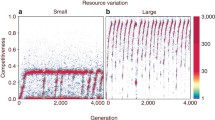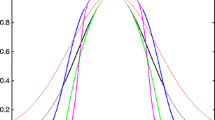Abstract
The evolutionary consequences of asymmetric competition between species are poorly understood in comparison with symmetric competition. A model for evolution of body size under asymmetric competition within and between species is described. The model links processes operating at the scale of the individual to that of macroscopic evolution through a stochastic mutation–selection process. Phase portraits of evolution in a phenotype space characteristically show character convergence and parallel character shifts, with character divergence being relatively uncommon. The asymptotic states of evolution depend very much on the properties of asymmetric competition. Given relatively weak asymmetries between species, a single equilibrium point exists; this is a local attractor, and its position is determined by the intra- and interspecific asymmetries. When the asymmetries are made stronger, several fixed points may come about, creating further equilibrium points which are local attractors. It is also possible for periodic attractors to occur; such attractors comprise Red Queen dynamics with phenotype values that continue to change without ever settling down to constant values. From certain initial conditions, evolution leading to extinction of one of the species is also a likely outcome.
Similar content being viewed by others
References
Abrams, P.A. (1987) Alternative models of character displacement and niche shift. 2. Displacement when there is competition for a single resource. Am. Nat. 130, 271–282.
Abrams, P.A. and Matsuda, H. (1994) The evolution of traits that determine ability in competitive contests. Evol. Ecol. 8, 667–686.
Abrams, P.A., Matsuda, H. and Harada, Y. (1993a) Evolutionarily unstable fitness maxima and stable fitness minima of continuous traits. Evol. Ecol. 7, 465–487.
Abrams, P.A., Harada, Y. and Matsuda, H. (1993b) On the relationship between quantitative genetic and ESS models. Evolution 47, 877–887.
Brown, J.S. and Pavlovic, N.B. (1992) Evolution in heterogeneous environments: Effects of migration on habitat specialization. Evol. Ecol. 6, 260–382.
Brown, J.S. and Vincent, T.L. (1987) Coevolution as an evolutionary game. Evolution 41, 66–79.
Brown, J.S. and Vincent, T.L. (1992) Organization of predator-prey communities as an evolutionary game. Evolution 46, 1269–1283.
Case, T.J. and Bolger, D.T. (1991) The role of interspecific competition in the biogeography of island lizards. Trends Ecol. Evol. 6, 135–139.
Christiansen, F.B. (1991) On the conditions for evolutionary stability for a continuously varying character. Am. Nat. 138, 37–50.
Clutton-Brock, T.H., Albon, S.D., Gibson, R.M. and Guinness, F.E. (1979) The logical stag: Aspects of fighting in red deer (Cervus elaphus L.). Anim. Behav. 27, 211–275.
Connell, J.H. (1980) Diversity and the coevolution of competitors, or the ghost of competition past. Oikos 53, 131–138.
Connell, J.H. (1983) On the prevalence and relative importance of interspecific competition: Evidence from field experiments. Am. Nat. 122, 661–696.
Davies, N.B. (1978) Territorial defence in the speckled wood butterfly (Pararge aegeria): The resident always wins. Anim. Behav. 26, 138–147.
Dieckmann, U. (1994) Coevolutionary Dynamics of Stochastic Replicator Systems. Berichte des Forschungszentrums Jülich (Jül-3018), Jülich, Germany.
Dieckmann, U. and Law, R. (1996) The dynamical theory of coevolution: A derivation from stochastic ecological processes. J. Math. Biol. 34, 579–612.
Dieckmann, U., Marrow, P. and Law, R. (1995) Evolutionary cycling in predator-prey interactions: Population dynamics and the Red Queen. J. Theor. Biol. 176, 91–102.
Englund, C., Johansson, F. and Olsson, T.I. (1992) Asymmetric competition between different taxa: Poecilid fishes and water striders. Oecologia 92, 498–502.
Fisher, R.A. (1958) The Genetical Theory of Natural Selection, 2nd edn. Dover Publications, New York.
Geritz, S.A.H., Kisdi, É., Meszéna, G. and Metz, J.A.J. (in press) Evolutionarily singular strategies and the adaptive growth and branching of the evolutionary tree. Evol. Ecol.
Goel, N.S. and Richter-Dyn, N. (1974) Stochastic Models in Biology. Academic Press, New York.
Goldberg, D.E. (1987) Neighbourhood competition in an old-field plant community. Ecology 68, 1211–1223.
Hofbauer, J. and Sigmund, K. (1990) Adaptive dynamics and evolutionary stability. Appl. Math. Lett. 3, 75–79.
Hutchinson, G.E. (1959) Homage to Santa Rosalia, or why are there so many kinds of animals. Am. Nat. 93, 145–159.
Iwasa, Y., Pomiankowski, A. and Nee, S. (1991) The evolution of costly mate preferences. II. The ‘handicap’ principle. Evolution 45, 1431–1442.
Lande, R. (1982) A quantitative genetic theory of life history evolution. Ecology 63, 607–615.
Lawton, J.H. and Hassell, M.P. (1981) Asymmetrical competition in insects. Nature 289, 793–795.
Marrow, P., Law, R. and Cannings, C. (1992) The coevolution of predator-prey interactions: ESSs and Red Queen dynamics. Proc. R. Soc. Lond. B 250, 133–141.
Marrow, P., Dieckmann, U. and Law, R. (1996) Evolutionary dynamics of predator-prey systems: An ecological perspective. J. Math. Biol. 34, 556–578.
Matsuda, H. and Abrams, P.A. (1994) Runaway selection to self-extinction under asymmetrical competition. Evolution 48, 1764–1772.
Maynard Smith, J. (1982) Evolution and the Theory of Games. Cambridge University Press, Cambridge.
Maynard Smith, J. and Brown, R.L. (1986) Competition and body size. Theor. Pop. Biol. 30, 166–179.
Metz, J.A.J., Nisbet, R.M. and Geritz, S.A.H. (1992) How should we define ‘fitness’ for general ecological scenarios? Trends Ecol. Evol. 7, 198–202.
Metz, J.A.J., Geritz, S. and Iwasa, Y. (1994) On the Classification of Evolutionarily Singular Strategies. University of Leiden Preprint, Leiden, The Netherlands.
Morin, C. and Johnson, E.A. (1988) Experimental studies of asymmetric competition among anurans. Oikos 53, 398–407.
Parker, G.A. (1983) Arms races in evolution — an ESS to the opponent-independent costs game. J. Theor. Biol. 101, 619–648.
Parker, G.A. (1985) Population consequences of evolutionarily stable strategies. In Behavioural Ecology: Ecological Consequences of Adaptive Behaviour (R.M. Sibly and R.H. Smith, eds), pp. 33–58. Blackwell Scientific, Oxford.
Parker, G.A. and Maynard Smith, J. (1990) Optimality theory in evolutionary biology. Nature Lond. 348, 27–33.
Pease, C.M. (1984) On the evolutionary reversal of competitive dominance. Evolution 38, 1099–1115.
Perfecto, I. (1994) Foraging behaviour as a determinant of asymmetric competitive interaction between two ant species in a tropical ecosystem. Oecologia 98, 184–192.
Pimentel, D. (1968) Population regulation and genetic feedback. Science 159, 1432–1437.
Robinson, S.K. and Terborgh, J. (1995) Interspecific aggression and habitat selection by Amazonian birds. J. Anim. Ecol. 64, 1–11.
Rosenzweig, M.L. and McCord, R.D. (1991) Incumbent replacement: Evidence for long-term evolutionary progress. Paleobiology 17, 202–213.
Roughgarden, J. (1983a) The theory of coevolution. In Coevolution (D.J. Futuyma and M. Slatkin, eds), pp. 33–64. Sinauer Associates, Sunderland, MA.
Roughgarden, J. (1983b) Coevolution between competitors. In Coevolution (D.J. Futuyma and M. Slatkin, eds), pp. 383–403. Sinauer Associates, Sunderland, MA.
Roughgarden, J.D. and Pacala, S.W. (1989) Taxon cycle among Anolis lizard populations: Review of the evidence. In Speciation and Its Consequences (D. Otte and J.A. Endler, eds), pp. 403–432. Sinauer Associates, Sunderland, MA.
Rummell, J.D. and Roughgarden, J. (1983) Some differences between invasion-structured and coevolution-structured competitive communities: A preliminary theoretical analysis. Oikos 41, 477–486.
Rummell, J.D. and Roughgarden, J. (1985) A theory of faunal buildup for competition communities. Evolution 39, 1009–1033.
Schoener, T.W. (1983) Field experiments on interspecific competition. Am. Nat. 122, 240–285.
Schwinning, S. and Fox, G.A. (1995) Population dynamic consequences of competitive symmetry in annual plants. Oikos 72, 422–432.
Slatkin, M. (1980) Ecological character displacement. Ecology 61, 163–177.
Takada, T. and Kigami, J. (1991) The dynamical attainability of ESS in evolutionary games. J. Math. Biol. 29, 513–529.
Taper, M.L. and Case, T.J. (1985) Quantitative genetic models for the coevolution of character displacement. Ecology 66, 355–371.
Taper, M.L. and Case, T.J. (1992a) Models of character displacement and the theoretical robustness of taxon cycles. Evolution 46, 317–333.
Taper, M.L. and Case, T.J. (1992b) Coevolution among competitors. In Oxford Surveys in Evolutionary Biology, Vol. 8 (D.J. Futuyma and J. Antonovics, eds). pp. 63–109. Oxford University Press, Oxford.
Taylor, P.D. (1989) Evolutionary stability in one parameter models under weak selection. Theor. Pop. Biol. 36, 125–143.
Thompson, P. and Fox, B.J. (1993) Asymmetric competition in Australian heathland rodents: A reciprocal removal experiment demonstrating the influence of size-class structure. Oikos 67, 264–278.
van Kampen, N.G. (1992) Stochastic Processes in Physics and Chemistry. North-Holland, Amsterdam.
Van Valen, L. (1973) A new evolutionary law. Evol. Theory 1, 1–30.
Vincent, T.L. and Brown, J.S. (1988) The evolution of ESS theory. Ann. Rev. Ecol. Syst. 19, 423–443.
Weiner, J. (1990) Asymmetric competition in plant populations. Trends Ecol. Evol. 5, 360–364.
Author information
Authors and Affiliations
Rights and permissions
About this article
Cite this article
Law, R., Marrow, P. & Dieckmann, U. On evolution under asymmetric competition. Evolutionary Ecology 11, 485–501 (1997). https://doi.org/10.1023/A:1018441108982
Issue Date:
DOI: https://doi.org/10.1023/A:1018441108982




